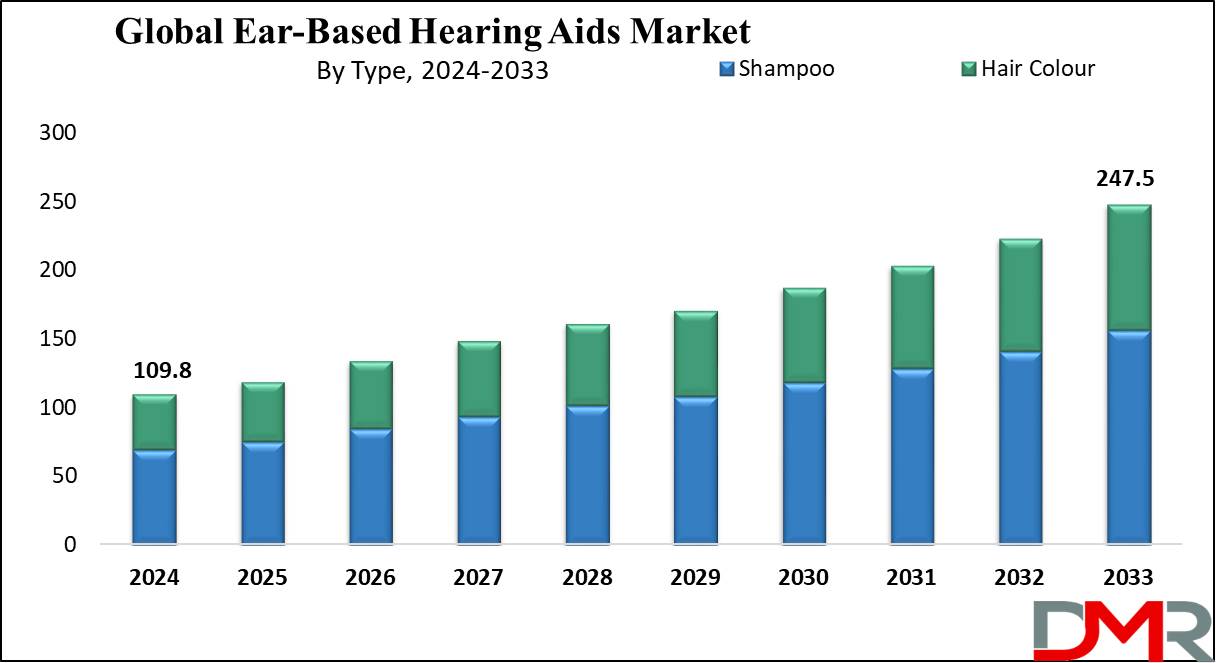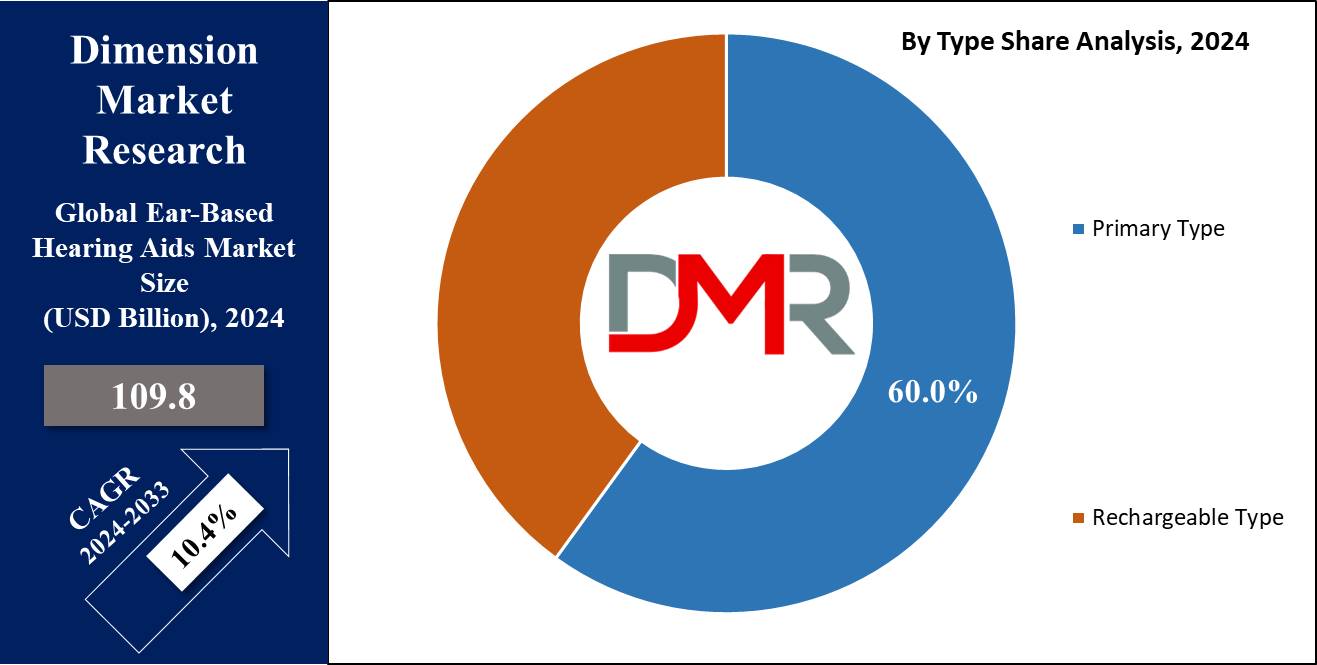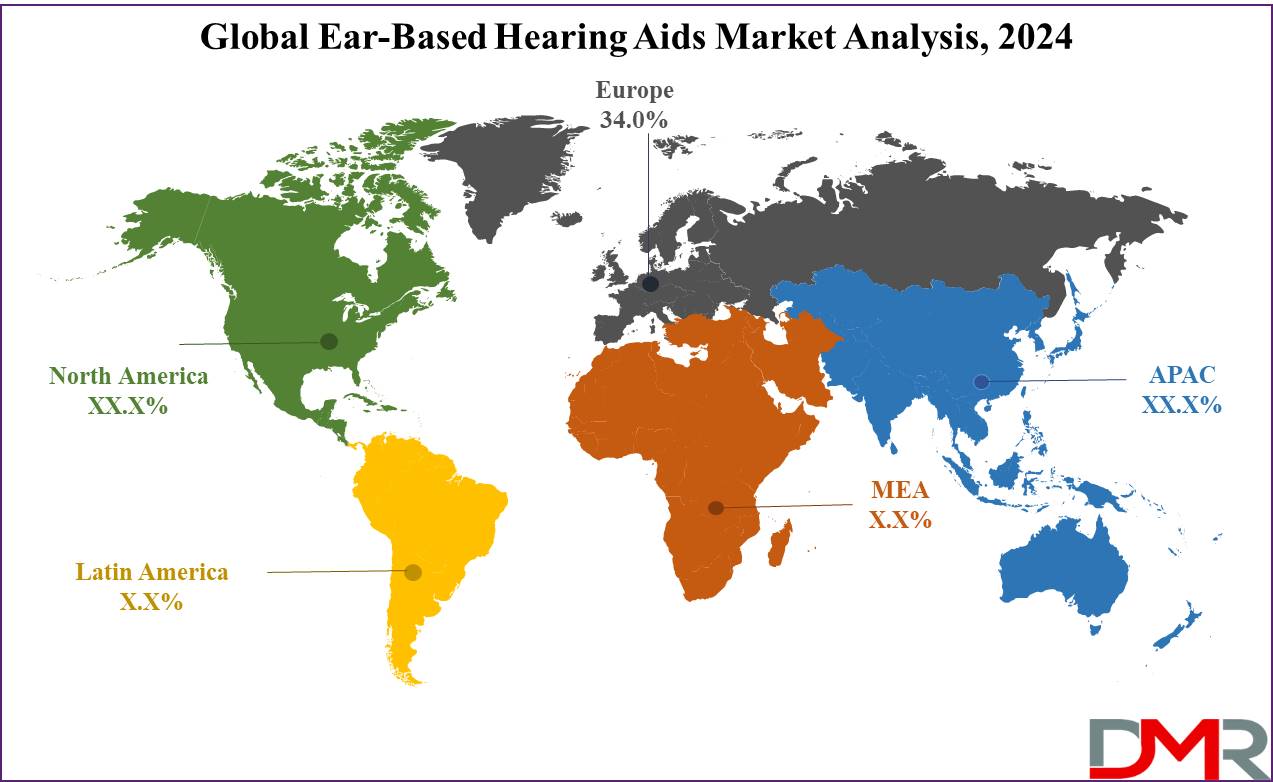Overview
Global Ear-Based Hearing Aids Market size was valued at USD 11.35 Bn in 2023 and it is further anticipated to reach a market value of USD 29.8 Bn in 2033 at a CAGR of 10.4%.

Hearing aids (sometimes referred to as deaf aids) are electroacoustic devices designed to amplify sound for its user. Their primary function is to make speech clearer and easier to comprehend while correcting hearing impairments identified through audiometry tests. Many types of hearing aids exist that address different forms of hearing loss.
Global Ear-Based Hearing Aids Market report offers an in-depth analysis of the target market, encompassing factual data like market size and shares at both regional and country levels, with CAGR and year-on-year growth rates. The report gives crystal view on market trends, opportunities, restrains and challenges along with competitive landscape analysis. Porters Five Forces, PESTLE, supply-chain analysis, Ecosystem analysis and Macro economic factors are included to cover all the target market aspects.
The research report on the global ear-based hearing aids market includes both qualitative as well as quantitative analysis of the market, company profiles of major market players along with complete product details and their competitive scenario. The report highly exhibits on the current and upcoming market trends and provides comprehensive analysis of all the factors that impact the global ear-based hearing aids market growth and size. The report will help companies to make better strategical business decisions.
Key Takeaways
- Market Size & Share: Ear-Based Hearing Aids Market size was valued at USD 11.35 Bn in 2023 and it is further anticipated to reach a market value of USD 29.8 Bn in 2033 at a CAGR of 10.4%.
- Type Analysis: Rechargeable Type hearing aids dominated the market in 2023, accounting for roughly 60% of market share.
- Application Analysis: Hearing Loss in the Elderly segment held approximately 70% market share by 2023.
- Regional Analysis: Europe holds the largest share in the Ear-Based Hearing Aids Market, accounting for an estimated 34%.
- Technological Advancements: Recent developments focus on AI integration, smart features, and enhanced connectivity, making hearing aids more multifunctional and user-friendly.
- Growth in Tele-audiology: The rise of tele-audiology and remote fitting services has expanded access to hearing care, particularly in underserved regions, contributing to market growth.
Use Cases
- Age-Related Hearing Loss (Presbycusis): Older adults frequently experience hearing loss due to aging. Ear-based hearing aids help them maintain social interactions and enhance their quality of life by improving their ability to hear conversations and environmental sounds.
- Noise-Induced Hearing Loss: Individuals exposed to loud environments, such as construction workers or musicians, often suffer from hearing loss. Hearing aids assist in restoring their hearing ability, allowing them to continue their professional activities with minimal disruption.
- Sudden Hearing Loss: Some people experience sudden sensorineural hearing loss due to infections, injuries, or other causes. Ear-based hearing aids provide a crucial solution to regain auditory function and restore communication abilities.
- Congenital Hearing Loss: Children born with hearing impairments can benefit from hearing aids, which help in the development of speech, language, and cognitive skills by amplifying sounds during critical developmental years.
- Tinnitus Management: Many modern hearing aids come equipped with features that help manage tinnitus, a condition characterized by ringing or buzzing in the ears, by masking the tinnitus sound and providing relief to sufferers.
Market Dynamics
Driver
As life expectancies increase, more individuals experience age-related hearing impairments that drive demand for hearing aids. Environment factors, including occupational noise exposure and recreational noise pollution; rising incidence of ear infections and congenital hearing conditions; as well as increasing awareness about hearing health and early intervention combined with advances in hearing aid technology are driving market growth, leading to individuals seeking these devices in order to enhance their quality of life.
Trend
A key trend in the Ear-Based Hearing Aids Market is the incorporation of advanced technologies into hearing aid devices, such as Bluetooth connectivity, AI-driven sound processing, and the incorporation of directional microphones. These features enable users to connect their hearing aids directly with smartphones for streaming audio directly as well as customize their hearing experience through apps. Furthermore, miniaturization has made hearing aids more discreet and comfortable - appealing more to aesthetic-oriented customers; additionally rechargeable batteries offer added convenience by eliminating frequent replacement needs.
Restraint
One of the primary restraints on Ear-Based Hearing Aids Market growth is its prohibitively expensive advanced hearing aids, especially in developing regions. Even with technological improvements, affordability remains an obstacle limiting access to these devices for those most in need. Additionally, their stigmatic image can discourage some individuals from seeking assistance and further limit market expansion.
Opportunity
The Ear-Based Hearing Aids Market presents ample opportunity, particularly in emerging economies with rapidly growing economies. As healthcare infrastructure strengthens and awareness of hearing health rises, demand for affordable and accessible hearing solutions increases in these regions. Manufacturers have the opportunity to design cost-effective devices tailored specifically for emerging markets. Personalization and customization in hearing aids offer companies an opportunity to differentiate their offerings and meet users' diverse needs. Tele-audiology services such as remote hearing assessments can also present a great way of reaching underserved populations.
The COVID-19 Pandemic & Recession: Impact on the Global Ear-Based Hearing Aids Market
Dimension Market Research has closely monitored the impact of COVID-19 and the recession on specific business segments, along with its short and long-term implications at both the global and regional levels. The initial outbreak of the COVID-19 pandemic caused unprecedented economic damage across numerous regions. The COVID-19 pandemic severely disrupted production, sales, and supply chain activities in developed as well as developing economies. Our report comprehensively covers the pre and post-COVID-19 impacts, along with an analysis of the recession's effects on the global ear-based hearing aids market.
Market Scope and Segmentation Analysis
Type Analysis
Primary Type hearing aids utilizing disposable batteries have historically been popular due to their wide availability and ease of use among users, but more recently rechargeable hearing aids have gained significant traction thanks to their convenience, environmental advantages, and advances in battery technology.

Rechargeable Type hearing aids dominated the market in 2023, accounting for roughly 60% of market share. This success can be attributed to consumer preference for hassle-free, eco-conscious options that eliminate battery replacement needs more frequently and long term solutions. Furthermore, technological improvements to rechargeable batteries have extended their life and reliability further making rechargeables an attractive long-term choice for users seeking long-term solutions. Furthermore, rechargeable hearing aids reflect wider global trends of sustainability and convenience that align with user preference preferences.
Application Analysis
Ear-Based Hearing Aids Market applications can generally be divided into three main categories: Congenital Hearing Loss, Elderly Hearing Loss, and Acquired Trauma. Hearing Loss in the Elderly segment held approximately 70% market share by 2023. This dominance can be attributed to an aging global population and associated age-related hearing loss (presbycusis), leading to more elderly experiencing hearing impairment and thus creating more demand for hearing aids tailored specifically towards this demographic.
Congenital hearing loss and acquired trauma both represent substantial portions of the market; however, due to early intervention and personalized care initiatives they comprise a lesser portion. Congenital hearing loss typically manifests itself at birth or early childhood and requires special devices for diagnosis; acquired trauma cases vary in their requirements depending on severity and cause. But their steady growth remains evident.
Market Analysis and Research Scope
We provide Comprehensive insights about the ear-based hearing aids market along with crucial Key factors such as market size, market CAGR, market potential, recent developments, trends, opportunities, new technologies and innovations, recent product launches, restraints and market regulations. This report will help our clients immensely in getting an inside out view of the ear-based hearing aids market by providing them with the complete information about the ear-based hearing aids market and its prominent players with their competitive analysis and strategies.
The global ear-based hearing aids market research report provides accurate estimations for the forecast period 2024 to 2033 based on in-depth research and analysis through rigorous compilation of exhaustive primary and secondary research data. The final data will be carried out after verifying the in-house research analysis by the key opinion leaders of the global ear-based hearing aids market. Our triangulate research method minimizes error margin and gives holistic view on the report.
The Global Ear-Based Hearing Aids Market Report is segmented on the basis of the following
Type
- Primary Type
- Rechargeable Type
Application
- Congenital
- Hearing Loss in Elderly
- Acquired Trauma
Geographical Segmentation of the Global Ear-Based Hearing Aids Market
Europe holds the largest share in the Ear-Based Hearing Aids Market, accounting for an estimated 34%. This dominance can be attributed to its aging population with high hearing loss rates as well as key industry players like Germany, Denmark and Switzerland having strong market shares. Furthermore, advanced healthcare infrastructure supports hearing aid adoption through widespread access to audiology services as well as government initiatives and favorable reimbursement policies, making Europe a leader in developing and dispersing hearing aids.

Region and Countries
North America
Europe
- Germany
- The U.K.
- France
- Italy
- Russia
- Spain
- Nordic
- Benelux
- Rest of Europe
Asia-Pacific
- China
- Japan
- South Korea
- India
- ANZ
- ASEAN
- Rest of Asia-Pacific
Latin America
- Brazil
- Mexico
- Argentina
- Colombia
- Rest of Latin America
Middle East & Africa
- Saudi Arabia
- UAE
- Israel
- South Africa
- Egypt
- Rest of MEA
The global ear-based hearing aids market research report provides competitive examination analysis of the leading players including company description, SWOT analysis, and financial information, exhaustive product portfolio with specifications, key business areas, market share analysis, acquisitions and mergers, and key developments, etc.
Competitive Landscape
The global ear-based hearing aids market is highly fragmented due to the presence of several leading players. Prominent market players of the ear-based hearing aids market are exhibiting a keen interest towards the emerging economies such as China, India, etc. to enhance their revenue generating opportunities. The major market players are continuously focusing on their product branding, marketing and expansion of R&D, to increase their customer base. Exhaustive key vendor analysis has been done to meet the ever-changing needs of our clients and provide them with a complete overview on the competitiveness of the global ear-based hearing aids market.
Global Ear-Based Hearing Aids Market Key Players:
- Sonova
- William Demant
- Sivantos
- GN ReSound
- Widex
- Starkey
- Rion
- Audina Hearing Instruments
- Sebotek Hearing Systems
- Microson
- Horentek
- Audicus
- Arphi Electronics
Recent Developments
- AI Integration and Smart Features: 2023 marked major advances in hearing aid AI integration. Leading manufacturers introduced hearing aids capable of automatically adapting to different sound environments, providing users with an enjoyable auditory experience. In addition, these hearing aids offered real-time translation services as well as health monitoring features - setting new standards for multifunctional hearing aids.
- Expanded Rechargeable Hearing Aids: Rechargeable hearing aids saw significant growth between 2023-2024, as more companies introduced models with longer battery lives and quicker charging times - reflecting consumer interest for eco-friendly and convenient solutions that fueled this sector's expansion.
- Tele-audiology and Remote Fitting: Tele-audiology services have become more prevalent, providing users with remote hearing aid fittings and adjustments. This has increased accessibility of hearing care in remote and underserved areas and become a central focus for companies attempting to enhance customer service.
Report Details
| Report Characteristics |
| Market Size (2024) |
USD 12.4 Bn |
| Forecast Value (2033) |
USD 29.8 Bn |
| CAGR (2024-2033) |
10.4% |
| Historical Data |
2018 – 2023 |
| Forecast Data |
2024 – 2033 |
| Base Year |
2023 |
| Estimate Year |
2024 |
| Report Coverage |
Market Revenue Estimation, Market Dynamics, Competitive Landscape, Growth Factors and etc. |
| Segments Covered |
By Type (Primary Type, Rechargeable Type) By Application (Congenital, Hearing Loss in Elderly, Acquired Trauma) |
| Regional Coverage |
North America – The US and Canada; Europe – Germany, The UK, France, Russia, Spain, Italy, Benelux, Nordic, & Rest of Europe; Asia- Pacific– China, Japan, South Korea, India, ANZ, ASEAN, Rest of APAC; Latin America – Brazil, Mexico, Argentina, Colombia, Rest of Latin America; Middle East & Africa – Saudi Arabia, UAE, South Africa, Turkey, Egypt, Israel, & Rest of MEA |
| Prominent Players |
Sonova, William Demant, Sivantos, GN ReSound, Widex, Starkey, Rion, Audina Hearing Instruments, Sebotek Hearing Systems, Microson, Horentek, Audicus, Arphi Electronics |
| Purchase Options |
We have three licenses to opt for: Single User License (Limited to 1 user), Multi-User License (Up to 5 Users), and Corporate Use License (Unlimited User) along with free report customization equivalent to 0 analyst working days, 3 analysts working days and 5 analysts working days respectively. |